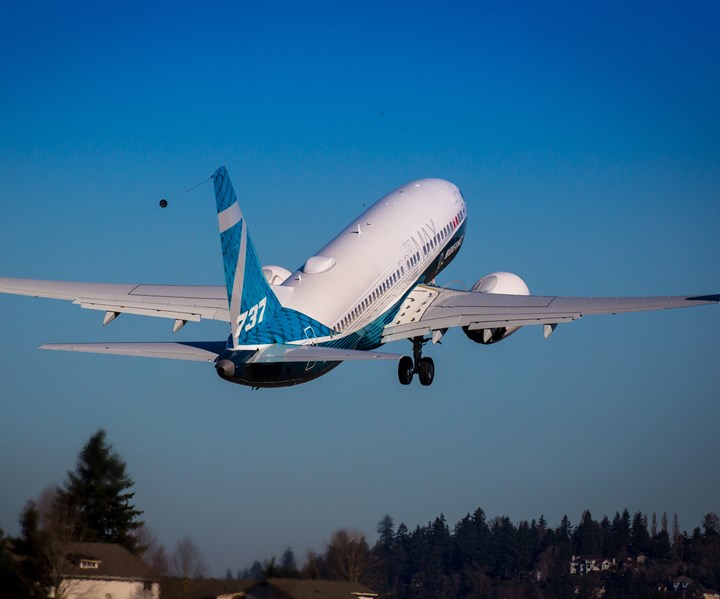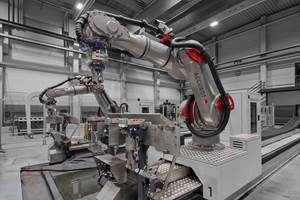Spirit AeroSystems initiates workforce reductions due to 737 MAX production suspension
Layoffs affecting 2,800 employees have been issued at the Wichita facility, due to ongoing production suspension and expected lower production going forward.

Boeing 737 MAX. Source | Boeing
On Jan. 10, Spirit AeroSystems (Wichita, Kan., U.S.) issued a notice under the Worker Adjustment and Retraining Notification Act of layoffs affecting approximately 2,800 employees at its Wichita, Kansas facility. Spirit reports that it is taking this action because of the Boeing 737 MAX production suspension, as well as ongoing uncertainty regarding the timing of when production will resume and the level of production when it does resume. Spirit says that this decision allows the company to begin aligning its cost structure to the production suspension and, after such suspension, what Spirit expects will be lower production levels than in 2019.
Spirit is a significant supplier on the 737 MAX program, with its workshare accounting for 70% of the airplane’s structure. This includes the entire fuselage, thrust reversers, engine pylons and wing components. In addition, the MAX represents more than 50% of Spirit’s annual revenue.
Spirit reports that it has not received notice from its customer, Boeing (Chicago, Ill., U.S.), on how long the production suspension will last or what the production rate will be in the future. Spirit believes that, when production resumes, the levels will be lower than previously expected, due, in part, to the customer’s need to consume more than 100 MAX shipsets currently in storage at Spirit’s facilities. In addition, Boeing has several hundred MAX airplanes built but not yet delivered to its customers.
“We continue to work with Boeing to develop a new production schedule for 2020 with an eye toward minimizing disruption, maintaining the stability of our production capabilities, and best positioning Spirit for the future.”
The company also plans to implement smaller workforce reductions later this month for its plants in Tulsa and McAlester, Oklahoma, which also produce components for the MAX. Based on final production rates agreed with Boeing, Spirit says it may have to take additional workforce actions in the future.
Employees will receive compensation for the applicable 60-day notice period, and affected employees will start exiting the company beginning Jan. 22. Th company reports that it has taken steps to lessen the impact of expected layoffs, transferring some 737 MAX employees to other programs where possible, and making plans to facilitate job fairs with other aerospace companies to help laid-off employees transition to new jobs.
“The difficult decision announced today is a necessary step given the uncertainty related to both the timing for resuming 737 MAX production and the overall production levels that can be expected following the production suspension,” says Tom Gentile, Spirit AeroSystems president and CEO. “We are taking these actions to balance the interests of all of our stakeholders as a result of the grounding of the 737 MAX, while also positioning Spirit to meet future demand.”
“Our goal is to support Boeing and a safe return to service of the MAX,” Gentile adds. “We continue to work with Boeing to develop a new production schedule for 2020 with an eye toward minimizing disruption, maintaining the stability of our production capabilities, and best positioning Spirit for the future. When production levels increase sufficiently in the future, we look forward to recalling employees impacted by today’s announcement.”
Related Content
Welding is not bonding
Discussion of the issues in our understanding of thermoplastic composite welded structures and certification of the latest materials and welding technologies for future airframes.
Read MoreLow-cost, efficient CFRP anisogrid lattice structures
CIRA uses patented parallel winding, dry fiber, silicone tooling and resin infusion to cut labor for lightweight, heavily loaded space applications.
Read MoreOtto Aviation launches Phantom 3500 business jet with all-composite airframe from Leonardo
Promising 60% less fuel burn and 90% less emissions using SAF, the super-laminar flow design with windowless fuselage will be built using RTM in Florida facility with certification slated for 2030.
Read MoreAutomated robotic NDT enhances capabilities for composites
Kineco Kaman Composites India uses a bespoke Fill Accubot ultrasonic testing system to boost inspection efficiency and productivity.
Read MoreRead Next
Cutting 100 pounds, certification time for the X-59 nose cone
Swift Engineering used HyperX software to remove 100 pounds from 38-foot graphite/epoxy cored nose cone for X-59 supersonic aircraft.
Read MoreUltrasonic welding for in-space manufacturing of CFRTP
Agile Ultrasonics and NASA trial robotic-compatible carbon fiber-reinforced thermoplastic ultrasonic welding technology for space structures.
Read MoreCeramic matrix composites: Faster, cheaper, higher temperature
New players proliferate, increasing CMC materials and manufacturing capacity, novel processes and automation to meet demand for higher part volumes and performance.
Read More.jpg;width=70;height=70;mode=crop)












